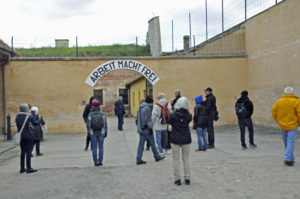
Inside the Small Fortress at Terezin, Czech Republic (Photo by Don Knebel)
In 1780 Habsburg Emperor Joseph II built a citadel (Small Fortress) on the east side of the Ohře River and a walled town (Main Fortress) across the river for his troops. Joseph named the area Terezin in honor of his mother, Maria Theresa. The Small Fortress eventually imprisoned Gavrilo Princip, whose assassination of Archduke Ferdinand in Sarajevo helped precipitate World War I.
In 1940, after occupying Czechoslovakia, Hitler began using the Small Fortress as a concentration camp for Jews rounded up in nearby areas. As it did in other camps, the Gestapo posted “Arbeit Macht Frei” at the prison entrance. The slogan, meaning “Work Sets You Free,” was a cruel hoax. Most of the Jews brought to Terezin were destined for the death camps of Auschwitz-Birkenau and Treblinka. In late 1941 the Germans evicted the non-Jewish residents from the Main Fortress, which they called Theresienstadt, and converted the town into a ghetto. Terezin, built for a population of 5000, eventually held 55,000 Jews. In 1942, a crematorium was built near the severely overcrowded town to accommodate the dozens of people who died every day from starvation and disease. Others were shot for trivial offenses.
By the time Terezin was liberated by the Allies on May 9, 1945, about 150,000 Jews had been sent there. About 33,000 of them died at Terezin and about 90,000 more were sent on to be killed. Today, the Small Fortress, returned to its wartime condition, is maintained as a memorial to the victims. A small museum in the Main Fortress displays drawings of the children who lived there before being shipped off to their deaths.